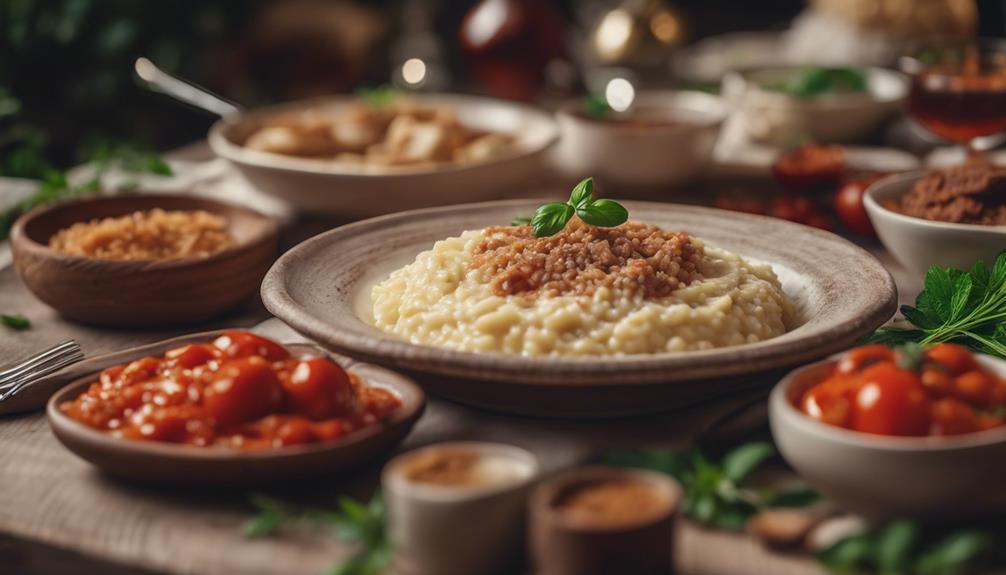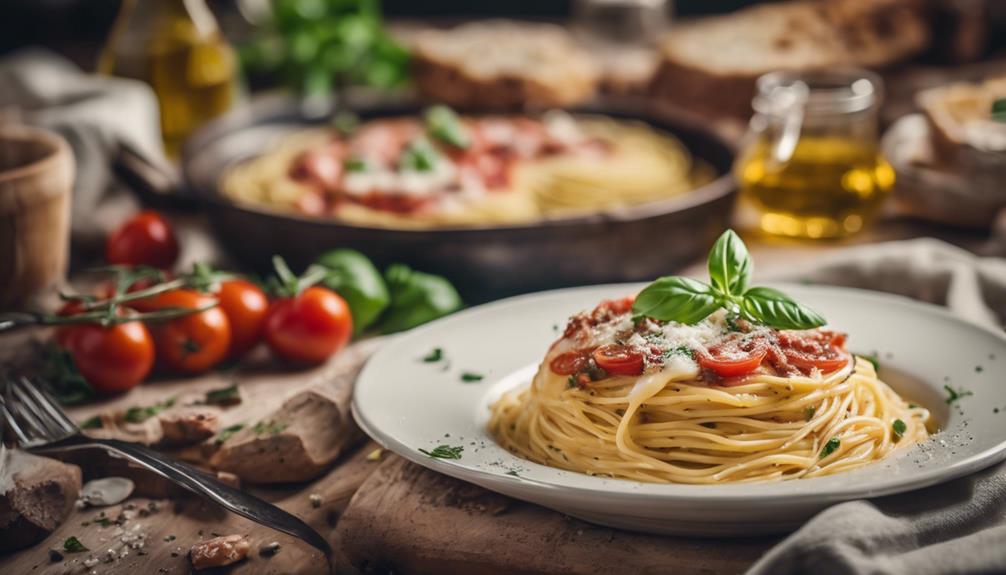To make an authentic Antipasto Salad, you will need cured meats like salami, cheeses such as mozzarella, mixed greens, and olives for a true Italian experience. The key is using fresh ingredients, with marinated vegetables adding flavor and cheeses providing a creamy element. Finish it off by drizzling with a tasty olive oil dressing to tie everything together. This traditional starter encompasses a variety of flavors and textures, making it an ideal beginning to any meal. By exploring the intricacies of each element, you uncover the genuine essence of this iconic Italian dish.
Key Takeaways
- Classic antipasto salad combines cured meats, cheeses, and vegetables.
- Freshness of ingredients is crucial for optimal flavor.
- Olive oil dressing ties the diverse flavors together.
- Versatile dish suitable for casual or formal dining occasions.
- Offers a balanced mix of nutrients for a wholesome meal option.
Classic Antipasto Salad Recipe
If you're looking to recreate the classic antipasto salad at home, start by gathering an assortment of cured meats, cheeses, olives, and fresh vegetables. The Italian antipasto salad is a delightful mix of flavors and textures, offering a vibrant and appetizing start to your meal.
To make this salad, you'll need a variety of ingredients, such as marinated vegetables, different types of cheese, and a tangy olive oil dressing. The key to a successful antipasto salad lies in the freshness of the components. Choose ripe and flavorful olives, crisp vegetables, and high-quality cured meats to elevate the dish.
The marinated vegetables add a burst of flavor, while the cheeses provide a creamy and savory element. When combined with the olive oil dressing, these ingredients create a harmonious blend that's quintessentially Italian.
Get ready to indulge in a salad that captures the essence of traditional Italian cuisine with every bite.
Main Ingredients for Antipasto Salad
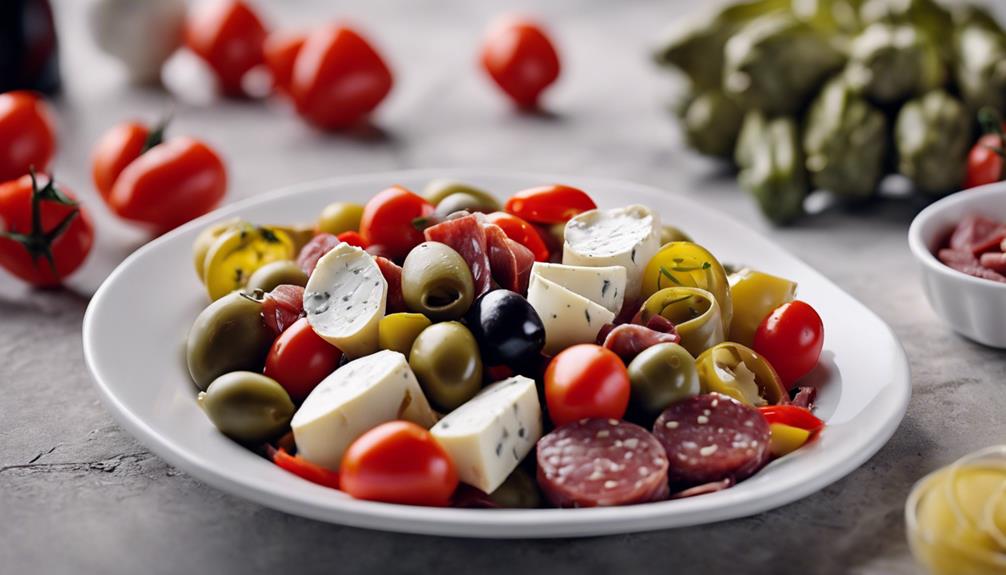
To craft a delicious Antipasto Salad, begin by gathering the main ingredients that typically include a variety of cured meats, cheeses, vegetables, and greens. Here is a breakdown of the key components you will need for your Italian-inspired salad:
| Main Ingredients | Description |
|---|---|
| Cured Meats | Salami, prosciutto, etc. |
| Cheeses | Mozzarella, provolone, feta |
| Vegetables | Artichoke hearts, olives, roasted red peppers, cherry tomatoes |
| Greens | Mixed greens, romaine lettuce, arugula |
In addition to these main elements, you may also want to contemplate adding flavorful accents like olive oil, lemon olive oil dressing, and herbs for a well-rounded taste profile. The combination of these ingredients creates a harmonious blend of savory, salty, and fresh flavors that are characteristic of the traditional Antipasto Salad. Gather these items to prepare your own delightful Italian salad that is sure to impress your guests with its vibrant colors and rich taste.
Step-by-Step Antipasto Salad Instructions
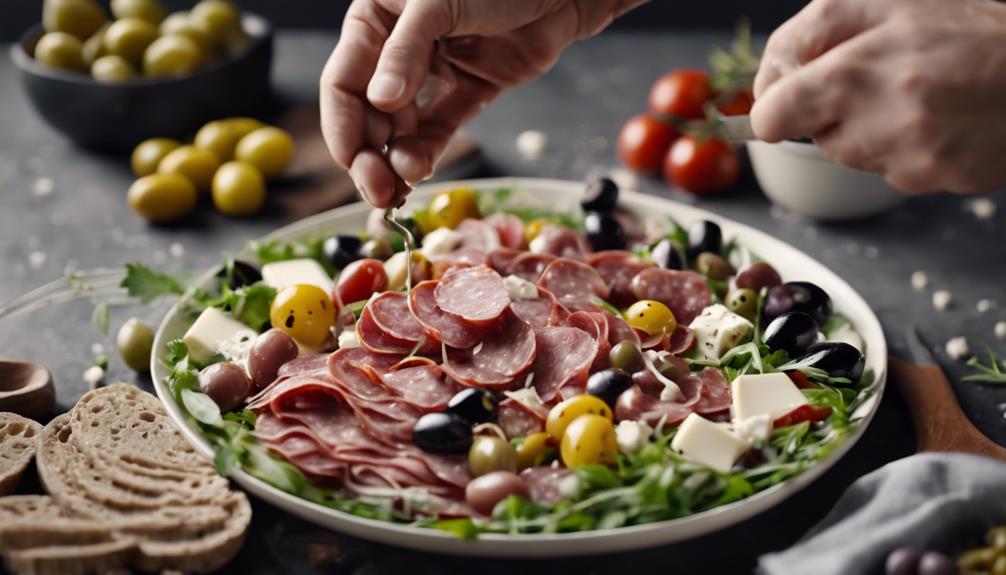
Begin by assembling all the main ingredients listed earlier to prepare your flavorful Antipasto Salad. Gather fresh basil leaves, cherry tomatoes, romaine lettuce, provolone cheese, and a selection of Italian charcuterie. For the dressing, you'll need olive oil, either store-bought or homemade light lemon olive oil for a zesty touch.
To start, wash and chop the romaine lettuce into bite-sized pieces and slice the cherry tomatoes in half. Cut the provolone cheese and Italian charcuterie into thin slices or bite-sized pieces for easy eating.
Next, arrange the romaine on a serving platter or in a large salad bowl. Layer the cherry tomatoes, provolone cheese, and Italian charcuterie on top of the romaine.
Drizzle the olive oil dressing over the salad, ensuring each ingredient is lightly coated. Add a sprinkle of fresh basil leaves for a pop of color and flavor.
Your Antipasto Salad is now ready to be enjoyed as a delicious appetizer or light meal.
Customizing Your Antipasto Salad
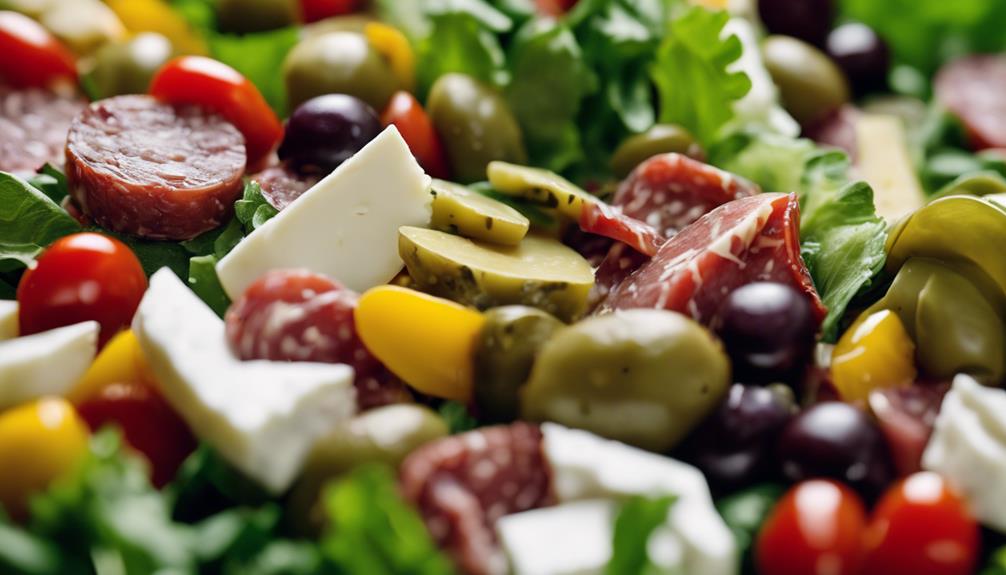
Enhance the flavors of your Antipasto Salad by incorporating a variety of customizable ingredients. Add your favorite cured meats like prosciutto or pepperoni to bring a savory and rich taste to the salad.
Mix in different types of cheeses such as Parmesan, gorgonzola, or aged cheddar for a delicious combination of flavors and textures.
Elevate the salad by including marinated artichoke hearts, roasted red peppers, or sun-dried tomatoes which will add a depth of flavor and a touch of tanginess.
Don't forget to include a variety of olives like Kalamata, green, or stuffed olives for a mix of salty and briny notes that complement the other ingredients well.
Experiment with different dressings such as a balsamic glaze, lemon herb vinaigrette, or a creamy Italian dressing to enhance the overall taste profile of your antipasto salad.
Customizing your antipasto salad with these ingredients will surely tantalize your taste buds and create a delightful culinary experience.
Storage Tips for Antipasto Salad
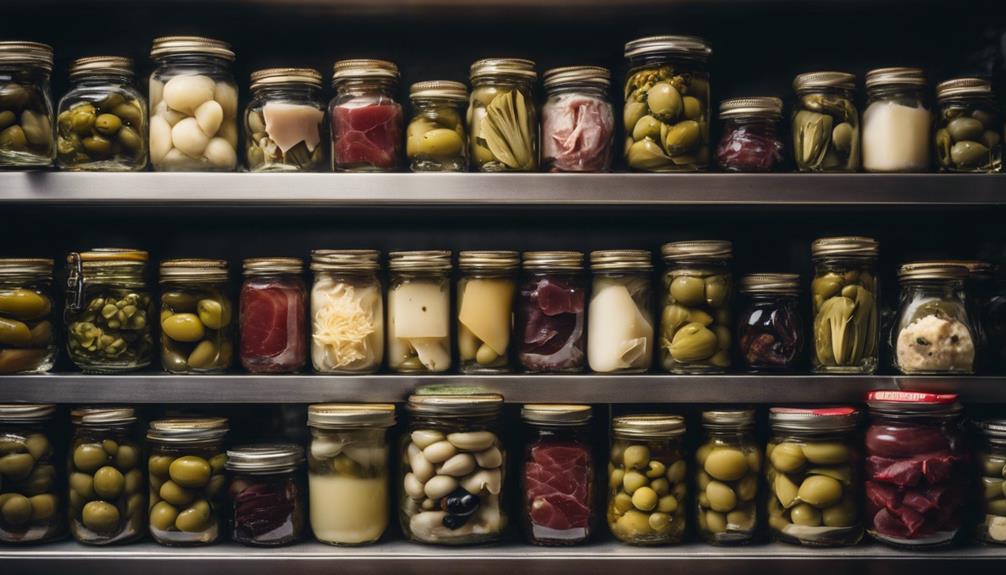
Store your antipasto salad in an airtight container in the refrigerator to maintain its freshness. By doing so, you can guarantee that the flavors of the various ingredients remain intact. It's advisable to keep the salad away from direct sunlight or heat sources, as exposure to these elements can lead to wilting or spoilage.
Antipasto salad can typically be stored in the refrigerator for 3-5 days, during which time the flavors may intensify, enhancing the overall taste experience.
It is essential to avoid freezing antipasto salad, as freezing can alter the texture and flavors of the ingredients, compromising the quality of the dish. Before serving any leftover antipasto salad, it's recommended to give it a quick toss to redistribute the dressing and flavors evenly. This step ensures that each bite delivers a harmonious blend of the different components, maintaining the integrity of the dish.
Pairing Antipasto Salad With Other Dishes

To create a delightful dining experience, consider pairing your antipasto salad with a variety of complementary dishes.
- Italian-style Vegetarian Dishes: Enhance the flavors by serving antipasto salad alongside Italian classics like Caprese salad or a grilled vegetable platter.
- Main Dishes: Elevate your meal by combining antipasto salad with main courses such as pasta, pizza, or risotto for a satisfying and well-rounded dining experience.
- Seafood Dishes: For a balanced and flavorful option, pair antipasto salad with seafood dishes like grilled shrimp or salmon to add a touch of invigorating freshness.
- Dessert: Conclude your meal on a light note by offering invigorating desserts like fruit salad or lemon sorbet after enjoying the savory goodness of antipasto salad.
The versatility of antipasto salad makes it suitable for various dining occasions, from casual gatherings to formal dinners. By exploring different pairings with Italian-style dishes, main courses, seafood options, and delightful desserts, you can create a harmonious and satisfying meal for yourself and your guests.
Antipasto Platter Ideas
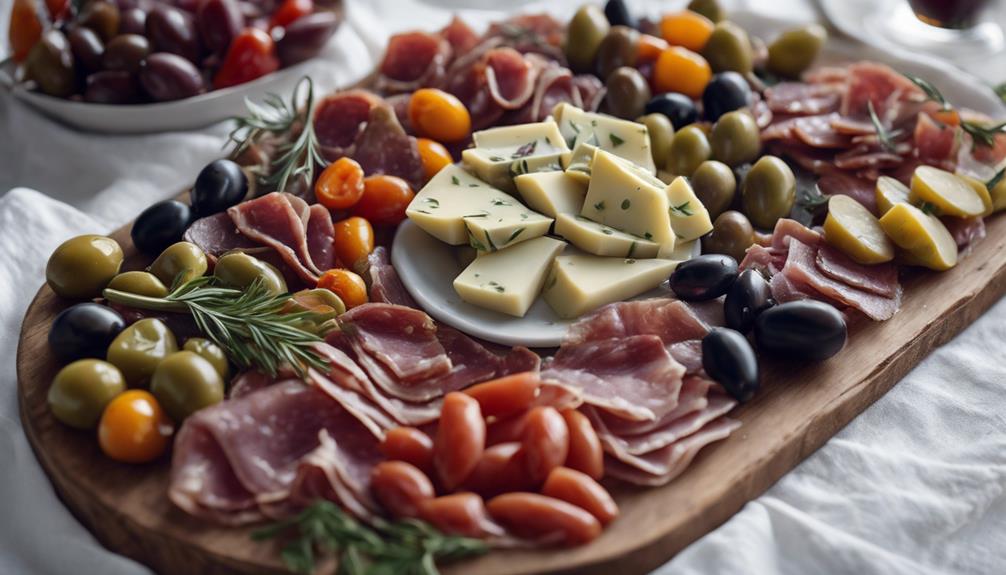
When planning your antipasto platter, consider incorporating a diverse selection of cured meats, cheeses, olives, and vegetables to create a visually appealing and flavorful spread. In Italian cuisine, antipasto platters are a traditional appetizer that sets the stage for a delicious meal. To create an enticing antipasto platter, you can include a variety of cured meats such as prosciutto, salami, and coppa, along with an assortment of cheeses like mozzarella, provolone, and gorgonzola. Adding a mix of olives – green, kalamata, and stuffed – brings a briny contrast to the richness of the meats and cheeses. Complement these elements with a selection of marinated vegetables such as artichoke hearts, roasted red peppers, and pickled onions to enhance the flavors and textures on the platter. Below is a table showcasing some classic components you can include in your antipasto platter:
| Cured Meats | Cheeses | Vegetables |
|---|---|---|
| Prosciutto | Mozzarella | Olives |
| Salami | Provolone | Artichokes |
| Coppa | Gorgonzola | Roasted Peppers |
Antipasto Salad for Meal Prep

When meal prepping antipasto salad, you benefit from the convenience of having a ready-made meal at your fingertips.
The flavors of the salad intensify over time, creating a more delicious eating experience.
Meal Prep Benefits
Preparing antipasto salad in advance offers numerous benefits for your meal prep routine, making it a convenient and flavorful option to have on hand for busy days. Here are some advantages of incorporating antipasto salad into your meal prepping:
- Time-Saving: By making antipasto salad ahead of time, you can save precious minutes during hectic weekdays, ensuring you have a satisfying meal ready to go.
- Enhanced Flavors: The flavors in antipasto salad have time to meld together when prepared in advance, resulting in a more robust and delicious taste experience.
- Portion Control: Dividing the antipasto salad into individual containers during meal prep allows for better portion control, aiding in maintaining a balanced and healthy eating plan.
- Grab-and-Go Convenience: Having pre-made antipasto salad readily available means you can quickly grab a nutritious meal without sacrificing flavor or quality, even when you're on the move.
Storage Tips
For peak freshness and flavor retention, store your antipasto salad in an airtight container in the refrigerator for 3-5 days. This method guarantees that the diverse flavors of the antipasto salad remain intact while preserving its texture.
The refrigerator's cool temperature helps maintain the quality of the ingredients, preventing them from spoiling prematurely. When storing the salad, it's essential to keep it well-covered to shield it from absorbing any unwanted odors present in the fridge that could alter its taste.
Additionally, consider storing the dressing separately and only adding it to the salad right before serving. This practice helps prevent the salad from becoming soggy due to the dressing's moisture.
Health Benefits of Antipasto Salad
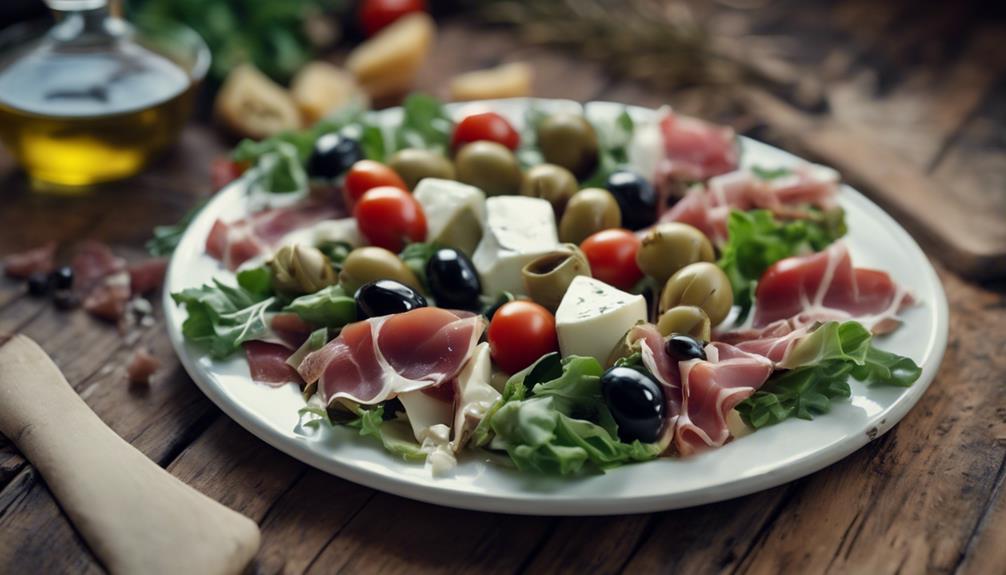
Indulging in antipasto salad offers a plethora of health benefits due to its nutrient-dense ingredients and vibrant flavors.
Nutrient-Rich Ingredients: Antipasto salad is packed with nutritious elements like leafy greens, lean meats, cheeses, and olives, providing a balanced mix of protein, healthy fats, and antioxidants.
Vitamins and Minerals: The salad contains a variety of essential nutrients such as vitamin A, vitamin C, potassium, and calcium, which are essential for overall health and wellbeing.
Heart-Healthy Olive Oil: The homemade dressing in antipasto salad often includes heart-healthy olive oil, rich in monounsaturated fats that have been linked to numerous health benefits.
Fiber and Digestive Health: Ingredients like cherry tomatoes and avocado in the salad contribute fiber and essential nutrients, promoting good digestive health and a feeling of fullness.
Antipasto salad can serve as a wholesome and fulfilling meal option, offering a delightful mix of flavors and textures while supporting a balanced diet rich in whole foods.
Serving Antipasto Salad to Guests

When serving antipasto salad to guests, you're presenting a versatile and visually appealing dish that's sure to impress and satisfy a variety of tastes. This appetizer offers a delightful array of flavors and textures, making it a crowd-pleasing option for gatherings of all kinds.
The colorful presentation of antipasto salad not only adds visual appeal to your table but also showcases your attention to detail in meal planning, reflecting your culinary skills.
Antipasto salad can be served as a starter before the main course or as a standalone dish for lighter meals. Its versatility allows it to pair seamlessly with a variety of main dishes, making it a valuable addition to any menu.
Frequently Asked Questions
What Does an Antipasto Salad Contain?
An antipasto salad typically contains a mix of cured meats, cheeses, marinated vegetables, and fresh tomatoes, all atop a bed of crisp lettuce. You can add extras like roasted red peppers or anchovies for more flavor.
What Does Italian Antipasto Consist Of?
Italian antipasto consists of a delightful mix of cured meats, cheeses, and marinated vegetables. Imagine a vibrant palette of flavors and textures, from salty prosciutto to creamy mozzarella and tangy olives. It's a true culinary masterpiece!
What Is the Most Popular Antipasto in Italy?
The most popular antipasto in Italy is a traditional platter featuring a variety of cured meats, cheeses, olives, and pickled vegetables. It's known for its savory and flavorful components that stimulate the appetite before the main course.
What Is the Difference Between Antipasto and Antipasti?
When comparing antipasto and antipasti, remember antipasto is a specific appetizer course, while antipasti includes a variety of appetizers. Now, here's an interesting fact: Did you know Italy has over 400 types of cheese?
What Are Some Classic Italian Appetizers Besides Antipasto Salad?
Some classic Italian appetizers besides antipasto salad include bruschetta, arancini, and caprese skewers. However, if you’re looking for a warm and comforting option, you can’t go wrong with a creamy mushroom risotto recipe. Its rich, savory flavors make it a perfect starter for any Italian meal.
Conclusion
To sum up, the Antipasto Salad is a classic Italian appetizer that offers a delicious and satisfying combination of flavors and textures.
With its versatile ingredients and customizable options, this dish is perfect for any occasion.
Whether enjoyed as a meal on its own or as part of a larger spread, the Antipasto Salad is sure to impress your guests and leave them craving for more.
As the saying goes, 'A taste of Italy in every bite.'



